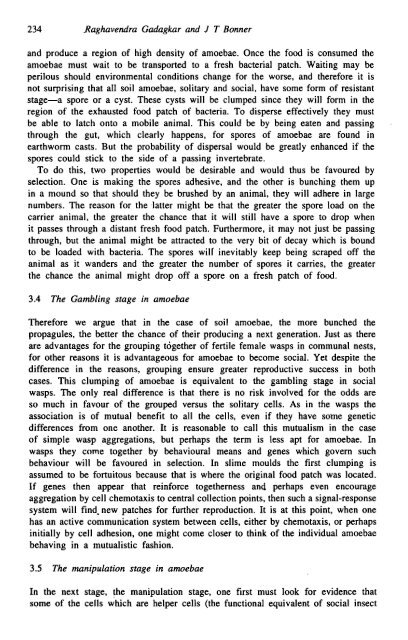Social insects and social amoebae. - Centre for Ecological Sciences
Social insects and social amoebae. - Centre for Ecological Sciences
Social insects and social amoebae. - Centre for Ecological Sciences
Create successful ePaper yourself
Turn your PDF publications into a flip-book with our unique Google optimized e-Paper software.
234 Raghavendra Gadagkar <strong>and</strong> J T Bonner<strong>and</strong> produce a region of high density of <strong>amoebae</strong>. Once the food is consumed the<strong>amoebae</strong> must wait to be transported to a fresh bacterial patch. Waiting may beperilous should environmental conditions change <strong>for</strong> the worse, <strong>and</strong> there<strong>for</strong>e it isnot surprising that all soil <strong>amoebae</strong>, solitary <strong>and</strong> <strong>social</strong>, have some <strong>for</strong>m of resistantstage-a spore or a cyst. These cysts will be clumped since they will <strong>for</strong>m in theregion of the exhausted food patch of bacteria. To disperse effectively they mustbe able to latch onto a mobile animal. This could be by being eaten <strong>and</strong> passingthrough the gut, which clearly happens, <strong>for</strong> spores of <strong>amoebae</strong> are found inearthworm casts. But the probability of dispersal would be greatly enhanced if thespores could stick to the side of a passing invertebrate.To do this, two properties would be desirable <strong>and</strong> would thus be favoured byselection. One is making the spores adhesive, <strong>and</strong> the other is bunching them upin a mound so that should they be brushed by an animal, they will adhere in largenumbers. The reason <strong>for</strong> the 1atter might be that the greater the spore load on thecarrier animal, the greater the chance that it will still have a spore to drop whenit passes through a distant fresh food patch. Furthermore, it may not just be passingthrough, but the animal might be attracted to the very bit of decay which is boundto be loaded with bacteria. The spores wilr inevitably keep being scraped off theanimal as it w<strong>and</strong>ers <strong>and</strong> the greater the number of spores it carries, the greaterthe chance the animal might drop off a spore on a fresh patch of food.3.4 The Gambling stage in <strong>amoebae</strong>There<strong>for</strong>e we argue that in the case of soil <strong>amoebae</strong>, the more bunched thepropagules, the better the chance of their producing a next generation. Just as thereare advantages <strong>for</strong> the grouping together of fertile female wasps in communal nests,<strong>for</strong> other reasons it is advantageous <strong>for</strong> <strong>amoebae</strong> to become <strong>social</strong>. Yet despite thedifference in the reasons, grouping ensure greater reproductive success in bothcases. This clumping of <strong>amoebae</strong> is equivalent to the gambling stage in <strong>social</strong>wasps. The only real difference is that there is no risk involved <strong>for</strong> the odds areso much in favour of the grouped versus the solitary cells. As in the wasps theassociation is of mutual benefit to all the cells, even if they have some geneticdifferences from one another. It is reasonable to call this mutualism in the caseof simple wasp aggregations, but perhaps the term is less apt <strong>for</strong> <strong>amoebae</strong>. Inwasps they come together by behavioural means <strong>and</strong> genes which govern suchbehaviour will be favoured in selection. In slime moulds the first clumping isassumed to be <strong>for</strong>tuitous because that is where the original food patch was located.If genes then appear that rein<strong>for</strong>ce togetherness <strong>and</strong> perhaps even encourageaggregation by cell chemotaxis to central collection points, then such a signal-responsesystem will find, new patches <strong>for</strong> further reproduction. It is at this point, when onehas an active communication system between cells, either by chemotaxis, or perhapsinitially by cell adhesion, one might come closer to think of the individual <strong>amoebae</strong>behaving in a mutualistic fashion.3.5 The manipulation stage in <strong>amoebae</strong>In the next stage, fhe manipulation stage, one first must look <strong>for</strong> evidence thatsome of the cells which are helper cells (the functional equivalent of <strong>social</strong> insect
















